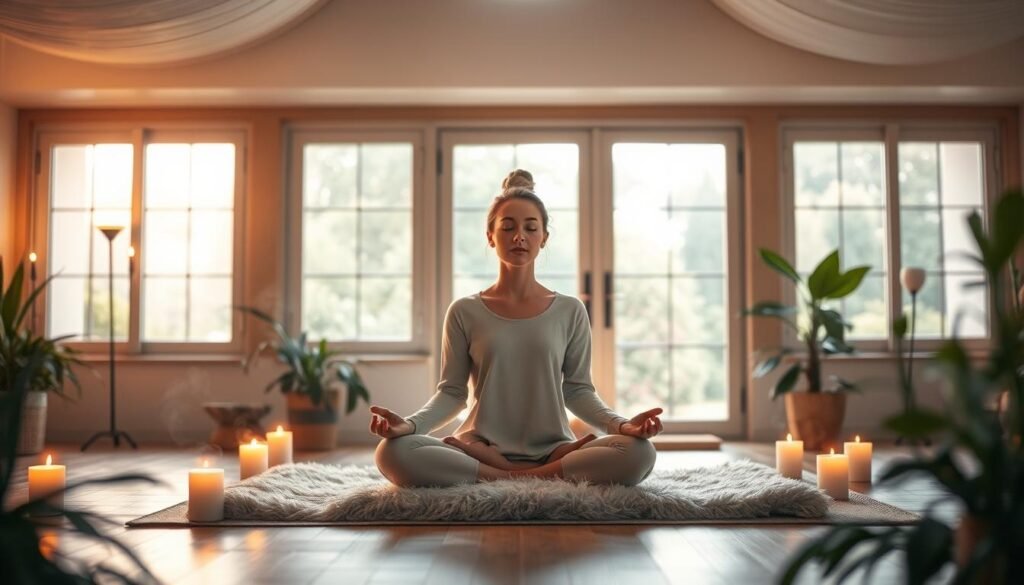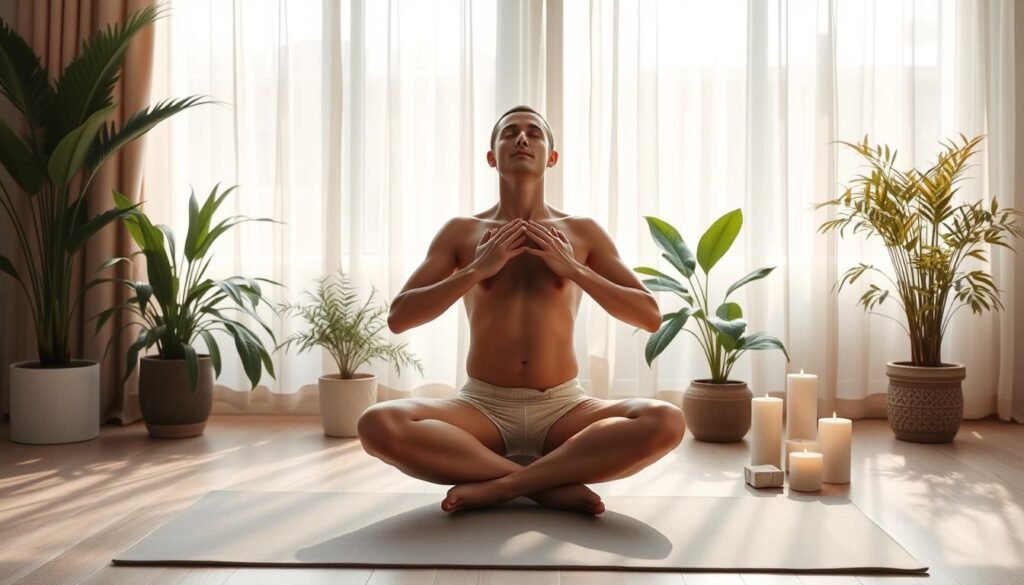Did you know the average healthy adult breathes about 12-20 breaths per minute? Many people breathe in short, shallow bursts without realizing it. This can make anxiety and chest pain worse. Learning effective breathing exercises to ease anxiety chest pain is crucial. This is especially true when stress takes a toll on our health. By practicing deep breathing techniques and adopting mindful practices, we can fight anxiety. Let’s look at different breathing exercises and their big benefits for our body and mind.
Key Takeaways
- Breathing exercises can reduce anxiety and alleviate chest pain.
- Slow, deep breathing techniques can help lower blood pressure.
- Consistent practice of breathing exercises is essential for optimal benefits.
- Mindfulness-based interventions enhance relaxation even further.
- The average adult breathes shallowly, contributing to increased anxiety.
- Breathing techniques can be practiced in sessions as short as a few minutes.
Understanding Anxiety and Chest Pain
Anxiety can cause a variety of physical symptoms, leading to the chest pain anxiety connection. People often feel a tightness in their chest during anxiety episodes. This adds to the stress-related symptoms they experience. When anxious, the body’s fight-or-flight response kicks in. This causes the uncomfortable feelings in the chest.
Chest pain is not the only symptom; sweating, trembling, or dizziness can also occur. Knowing about anxiety health effects helps people see how their feelings affect their body. It’s important to notice any unusual or severe symptoms. If you have sudden, intense chest pain or it spreads, get help right away.
It’s crucial to know the difference between anxiety and heart problems. Using breathing techniques can help manage anxiety and its effects. Slow, deep breaths help calm the body and lessen stress symptoms.
There are effective treatments for anxiety, like SSRIs and CBT. They address the relationship between mental and physical health. By understanding this link, people can better manage their overall well-being.
Common Symptoms of Anxiety and Associated Chest Pain
Many people with anxiety experience anxiety symptoms, including noticeable chest discomfort. This discomfort often feels like tightness in the chest. It can be mistaken for heart problems. Studies have found that 22% to over 70% of those having a panic attack feel chest pain. This pain usually lasts about 10 minutes. People are often concerned and want to know why it happens.
Physical Manifestations of Anxiety
Anxiety doesn’t just affect the mind; it impacts physical health and anxiety too. It can cause symptoms like a faster heart rate, sweating, and chest pain. People describe their chest pain in many ways, including:
- Constant dull aches
- Sharp shooting pains
- Burning sensations
- Uncontrollable muscle twitching
It’s important to know these symptoms to manage stress identification effectively. Research from 2018 shows that 25% to 50% of patients with low-risk chest pain also have high anxiety. Understanding these symptoms can help lessen worries.
Identifying Triggers for Chest Tightness
It’s critical to know what triggers anxiety triggers your chest tightness. Common triggers are:
- Public speaking
- Social interactions
- Stressful work situations
To ease chest tightness remedies, try using deep breaths, practicing mindfulness, or staying active. Being aware of what stresses you out helps in managing anxiety symptoms better. If you need more help, check out this link on reducing chest pain related to anxiety.
Exploring Breathing Techniques for Relaxation
Breathing techniques are crucial for managing anxiety and stress. They help control our emotions and lessen discomfort from anxiety. Proper breathing calms our nervous system. It boosts our well-being too.
Our autonomic nervous system controls body functions we don’t think about. Diaphragmatic breathing triggers relaxation and releases tension. This method lowers stress hormones and improves our health.
Practicing deep breathing brings many benefits. These relaxation methods help by:
- Boosting energy levels while increasing vitality
- Strengthening the immune system
- Enhancing circulatory health
- Supporting digestive functions
Just 10 minutes of diaphragmatic breathing daily can greatly relieve stress. Box Breathing is also great. It involves a pattern of inhaling, holding, exhaling, and pausing for four counts each. You can do it anywhere to quickly manage stress.
Guided Imagery uses visualization of peaceful places to engage the senses. It helps distract from negative thoughts and reduces stress. Progressive Muscle Relaxation (PMR) works by tensing and relaxing muscles from your feet to your face. It improves mental and physical relaxation.
Being consistent with these breathing techniques is crucial for full benefits. Chronic stress affects our physical and mental health, like increasing blood pressure. Regular practice can help balance our body and mind, building resilience against stress.
Common Breathing Exercises to Reduce Anxiety Chest Pain
Many people find that breathing exercises can help with anxiety and chest pain. Learning to manage your breath can lead to better mental and physical health. Here, we’ll look at three techniques. They all promote relaxed breathing and can increase relaxation overall.
Diaphragmatic Breathing Techniques
Diaphragmatic breathing uses the diaphragm to fill the lungs more fully. This method can lessen anxiety’s physical effects. Here’s how to do it:
- Choose a comfy position, sitting or lying down.
- Put one hand on your chest, the other on your belly.
- Inhale deeply through the nose, making your diaphragm expand, but keep the chest still.
- Exhale slowly through the mouth, using your belly muscles to push out the air.
Just 10 minutes of these exercises a day can bring noticeable relief from chest pain. They also help create a peaceful mind. Learn more about heart health and breathing exercises.
Lengthening Your Exhales
Longer exhales help you relax more deeply. By extending your breath out, you turn on the body’s calming system. Here’s a simple way to start:
- Inhale gently for four counts.
- Pause briefly, then exhale for six counts.
- With each breath out, imagine letting go of stress.
This method doesn’t just ease panic. It’s also great for managing general anxiety.
Equal Breathing Practices
Equal breathing makes inhalations and exhalations the same length. This balances your breathing rhythm. It’s also mindful and calming. Here’s how to try it:
- Breathe in through the nose for four counts.
- Exhale through the nose for four counts too.
Regular practice of this balanced breathing helps establish a soothing breathing pattern. Doing this even for a few minutes each day can sharpen focus and lower stress levels.
Mindful Breathing Exercises to Alleviate Stress
Adding mindful breathing exercises to your daily routine can make you feel more relaxed and lower your stress. It helps you become more aware, tapping into the good things breathing techniques offer. These practices create a strong bond between your mind and body, making you emotionally healthier.
The Role of Mindfulness in Breathing Techniques
Mindfulness is key in breathing exercises. It helps you stay focused on the moment. With mindful breathing, you can consistently ease stress by ignoring worrisome thoughts. We use techniques like:
- Beginner Breathing Exercise: Take five deep breaths.
- Simplest Technique Ratio: Inhale through the nose for one count, exhale through the mouth for two counts, and repeat.
- Exhale Technique Ratio: Inhale through the nose for three counts, exhale through the mouth for six counts.
- Variation for Exhale Technique: Inhale for two counts, exhale for four counts, or inhale for four counts, exhale for eight counts.
- Box Breathing Technique: Inhale for four counts, hold for four counts, exhale for four counts, hold for four counts.
- Alternate Nostril Breathing Steps: Inhale through the left nostril, pause, exhale through the right nostril, pause, inhale through the right nostril, pause, exhale through the left nostril, pause.
Doing these exercises often makes them more effective. This results in better mental clarity and relaxation.
Implementing Regular Mindful Sessions
Starting a daily routine with mindfulness breathing exercises can give you all its benefits. If you keep at it, you can:
- Feel fewer physical signs of anxiety, like chest pain.
- Be more emotionally strong and have better ways to cope.
- Have a healthier heart by breathing in ways that are good for your heart rate.
- Be better at noticing and handling things that make you anxious.
Making these mindful breathing exercises part of your day helps you actively manage stress. This path leads to a more peaceful and balanced life.
Beneficial Relaxation Methods for Stress Reduction
Exploring relaxation techniques can greatly help with anxiety management. By combining guided meditation and breathing exercises, people can better relax. This approach helps manage anxiety and makes meditation more effective, thanks to focused breathing and visualization. When people practice these together, they let go of anxious thoughts and feel calmer.
Integrating Guided Meditation with Breathing Exercises
Guided meditation and breathing exercises work well together for relaxation. This method helps people focus on inner pictures while they breathe. As they meditate, they learn to shift their thoughts away from stress. By using deep breathing, muscle relaxation, and visualization together, overall well-being improves.
The Impact of Meditation on Anxiety Management
Meditation helps a lot with managing anxiety. It makes people stronger emotionally, helping them deal with stress better. They’ll notice their heart rate slows, blood pressure drops, muscles relax, and focus improves. People also sleep better and feel less tired. These benefits come from doing relaxation techniques often, breathing better, and staying calm.

Panic Attack Relief: Emergency Breathing Strategies
Panic attacks are intense, lasting up to 30 minutes. They bring on symptoms like fast heartbeats, hard breathing, and feeling dizzy. But, there’s hope. Using the right emergency breathing methods can help. They calm anxiety fast during these moments. The Lion’s Breath and Alternate Nostril Breathing are two easy but powerful ways to feel better.
Quick Fixes During a Panic Attack
When panic hits, calming your emotions is key. Here’s what can really help:
- Find a quiet place to sit or lie down.
- Place one hand on your abdomen and the other on your chest.
- Concentrate on taking slow, deep breaths.
- Count your breaths to maintain focus, inhaling for four counts and exhaling for four counts.
Practicing Lion’s Breath and Alternate Nostril Breathing
Lion’s Breath and alternate nostril breathing are great for calming quick anxiety.
- Lion’s Breath: Stand or sit comfortably. Inhale deeply through the nose, filling the lungs. Open your mouth wide, stick out your tongue, and exhale forcefully while making a “ha” sound. This technique helps release tension.
- Alternate Nostril Breathing: Sit in a comfortable position. Close your right nostril with your thumb and inhale deeply through the left nostril. Close the left nostril with your ring finger, release the thumb from the right nostril, and exhale. Alternate this process for a few cycles to restore calmness and balance.
| Breathing Technique | Benefits | Steps |
|---|---|---|
| Lion’s Breath | Releases tension and improves oxygen flow | Inhale deeply, open mouth, exhale forcefully with “ha” sound |
| Alternate Nostril Breathing | Reduces stress levels and promotes calmness | Inhale left, close left, exhale right; alternate |
Using these strategies every day can be a big help in managing anxiety quickly. Knowing the signs and how to fight back brings control. And it can make you feel safe, even when anxiety tries to take over.
Integrating Breathing Exercises into Daily Life
Starting a breathing exercise routine can greatly improve your well-being. You can find many chances during the day to do exercises for anxiety. Keeping up with practice helps manage stress and anxiety. It lets your mind and body balance.
Creating a Consistent Breathing Routine
Adding breathing exercises to your day doesn’t take much time but brings big benefits. A regular routine helps you deal with anxiety better. Here are some tips to help start your routine:
- Choose specific times each day to practice, such as morning and evening.
- Utilize periodic reminders to maintain consistency in practice.
- Start with short sessions of 5-10 minutes to build up endurance.
- Experiment with various techniques to discover the most effective methods for personal needs.
Setting Up Your Environment for Effective Practice
Where you practice breathing exercises is key. A good environment makes you feel safe and relaxed. To make your space peaceful, try these suggestions:
- Find a quiet area in your home, free from distractions.
- Declutter the space to foster a calming atmosphere.
- Add elements such as soft lighting, comfortable seating, or soothing colors to promote peace.
- Incorporate calming scents using essential oils or candles to enhance relaxation.

Focus on your breathing routine and where you practice to better manage anxiety. Doing this regularly makes life more balanced and peaceful.
| Tip | Description |
|---|---|
| Time Allocation | Set aside specific times daily for breathing exercises. |
| Use Reminders | Utilize alarms or calendars to remind you to practice. |
| Short Sessions | Begin with 5-10 minute exercises to build comfort. |
| Personal Preference | Experiment with various techniques to find what works best. |
| Quiet Space | Find a serene location that promotes relaxation. |
| Decluttering | Remove excessive items to reduce distractions in your environment. |
| Soothing Elements | Integrate soft lighting, colors, and scents to cultivate a calming area. |
Consulting Healthcare Providers for Serious Concerns
It’s crucial to talk to healthcare pros if you have big worries about anxiety. This is especially true for signs like chest pain or trouble breathing. Knowing when to get help is central to handling anxiety well and staying safe.
Many people might not reach out because they’re unsure how serious their symptoms are or they’re afraid of being judged. But getting help for anxiety is a smart move for your mental health. This step can help get rid of those fears.
When to Seek Professional Help
Knowing certain signs that show you need a pro’s help is key. Look out for things like:
- Intense chest tightness or pain that messes with your day-to-day life
- Frequent shortness of breath with panic attacks
- Feeling hopeless or helpless all the time
- Your anxiety getting worse, affecting social life or work
These signs mean you should talk to a healthcare provider. Recognizing them can help you get the right advice. You’ll learn about the root causes of your anxiety and get help, maybe even therapy like CBT.
Understanding the Importance of Guided Support
Pros are key in showing you how to manage anxiety. Working with a healthcare provider helps you share your concerns in a safe space. They guide you with ongoing support, tracking your progress and tweaking your treatment as needed. Support options might include:
- Therapy for learning how to cope and stay mindful
- Medication to lessen anxiety symptoms
- Resources to help handle anxiety challenges
Taking steps toward mental health means trusting pros. You’re not alone in this fight against anxiety. The right support network can truly change your recovery path.
The Psychological Benefits of Proper Breathing
Learning about the psychological benefits of breathing can help us deal better with stress. Mastering proper breathing helps lessen anxiety and boosts our mental well-being. When we focus on our breath, we become more aware. This awareness helps us deal with stress better.
Enhancing Emotional Resilience
Breathing is a key way to cope with emotions. It helps us think before we react to stress. Techniques like cyclic sighing and box breathing teach us to breathe in a controlled way. This improves our mood and reduces anxiety signs. Using these techniques can make a big difference. They’re effective anxiety management tools.
Building Coping Mechanisms Through Breathing
Breathwork is crucial for handling anxiety. It’s not just for immediate relief but also helps in the long term. Diaphragmatic breathing and 4-7-8 breathing help lower stress and control emotions. Adding these exercises to our daily life betters mental health. This way, we create strong coping skills.

| Breathing Technique | Key Focus | Benefits |
|---|---|---|
| Cyclic Sighing | Prolonged exhalations | Improves mood, reduces respiratory rate |
| Box Breathing | Equal inhalations and exhalations | Calms nervous system, enhances focus |
| Diaphragmatic Breathing | Engaging the diaphragm | Increases lung capacity, lowers blood pressure |
| 4-7-8 Breathing | Controlled inhalation and exhalation | Promotes relaxation, reduces anxiety levels |
Conclusion
Breathing exercises play a huge role in reducing anxiety chest pain and improving overall health. Techniques like diaphragmatic breathing, balanced breathing, and mindful meditation help improve our moods. It’s important to understand how vital breathing is in anxiety management. Many studies show that breathing techniques can really help with stress and mental health.
These practices are safe and easy to include in our daily routines for better anxiety relief. It’s crucial to know that breathing techniques help both our minds and our bodies. To deal with life’s daily stress, it’s important to practice these methods consistently. This helps build our ability to withstand stress.
By keeping a positive attitude and practicing these techniques regularly, many can improve their anxiety levels. While options like cognitive behavioral therapy take time, breathing methods offer a quicker solution for anxiety. For those looking for fast relief, these breathing exercises are a great option.